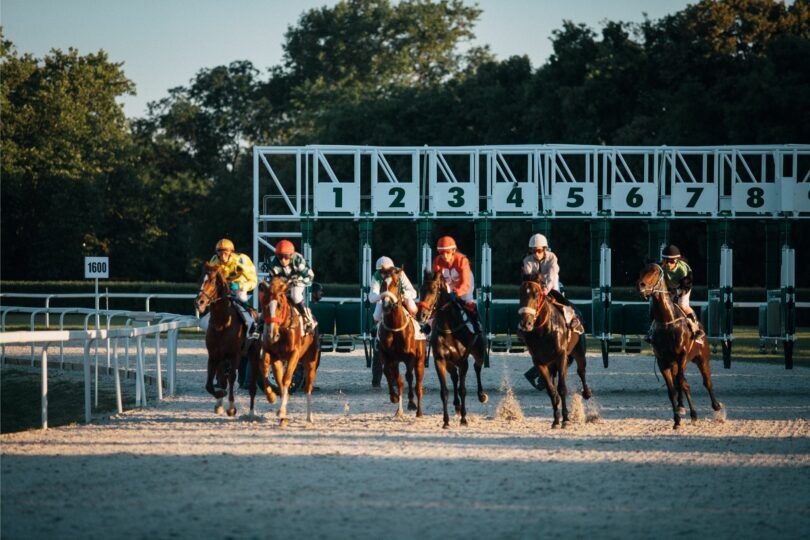Curious about gender equality in The Sport of Kings? While both female and male horses can be successful at the race track. But there are differences in how they compete.
Horse Racing: An Overview
Though formats differ by type and associated traditions, horse racing can be found all over the world.
What is horse racing?
This equine performance sport takes place between two or more horses. The horses are ridden and guided by jockeys over a set distance. While the exact distances and surfaces the horses race over vary, the overall gist is timeless—the fastest horse wins.
How old are racehorses?
A racehorse can start its racing career as young as two years of age. Sometimes, horses need more time to train and develop. This causes a delay in its debut, but it doesn’t mean the horse won’t be talented.
For example, the legendary racehorse Zenyatta didn’t make her first start until she was three.
The Gender Gap
Both males and females race, sometimes even against each other
Speaking of racehorses, both males and females race. It’s rare for them to race together, but sometimes fillies and mares beat colts and stallions.
Photo Cred: Canva
What percentage of racehorses are male vs female?
More than 60 percent of racehorses are male. That’s not to say female racehorses don’t earn a spot at the track.
Most owners purchase a racehorse as an investment. After racing, a male horse with a successful track record will likely have a successful stallion career. They can sire hundreds of foals in a year, with each breeding bringing owners a stud fee.
Mares can only be bred once a year and no return on the stud fee will be guaranteed until the foal either sells at auction or earns money at the racetrack.
What do you call male racehorses?
Male racehorses are referred to as colts until they’re four years old. At that point, they’re called stallions. If they are gelded, they’re referred to as geldings no matter their age.
What do you call female racehorses?
Female racehorses are called fillies until they’re four; then they are mares.
Photo Cred: Canva
Are male racehorses faster than females?
Male racehorses are not necessarily faster. Some believe there’s also an intimidation factor for female racehorses going up against males. However, fillies and mares have been able to best the boys enough that it’s not unheard of to race females against males.
| Pros | Cons | |
| Colts/Stallions/Geldings | Bigger, including stride length | Can be unpredictable |
| More aggressive on the track | More competition amongst races since racing has male races that are “open” for any gender to run | |
| Fillies/Mares | Typically less likely to spook | Can go into heat |
| Less competition amongst races since racing has female-only races available | Typically less purse money per race (i.e. Kentucky Derby purse is $3 million while the Kentucky Oaks is $1.25 million) |
Frequently Asked Questions
Q: Are all racehorses male?
Not at all! There have been several female racehorses over the years that have beaten the boys. Look up Zenyatta, Rachel Alexandra, Ruffian, and Regret, the last of which was the first filly to win the Kentucky Derby.
Q: Are racehorses male or female?
Both males and females race. There are different names for horses at certain ages. Colts are males that are three years old and under. Stallions are four years and older.
Geldings are a male horse that’s been castrated and can be any age. Fillies are females three and under. Mares are four and older.
Q: Are racehorses stallions?
Some stallions do race longer than their three-year-old year, but it’s becoming rare for the top three-year-old racehorses to race beyond that year. This is due to the owners desire to keep their investments safe.
It’s risky to race, but the risk increases with a horse’s age. They prefer to market a horse who has gone out on top, striking while the fire is hot to attract broodmare owners.
Q: How does handicapping work with males vs females?
Horses are assigned odds and weights by race stewards. Typically, females are given a weight allowance since they’re not as big as their male counterparts. This is done to even the playing field, so to speak.
When handicapping a race with both genders, however, gender does play a part in it.
Most of the time, the female racehorses don’t finish or perform as well as they would against other females. It’s something to consider, but you also need to weigh every horse’s previous performances just as you would any other race.
Photo Cred: Canva
Parting Thoughts
The glass ceiling of horse racing is still there, especially for the jockeys. But it’s got a few cracks in it. For example, fillies have won every leg of the Triple Crown races.
It’s becoming more and more common for females to race against males. Horse racing may soon see the day when the genders compete against each other more often.
P.S. Enjoy this article? Trot on over to:
- Furlong Fashion Guide: What to Wear to a Horse Race
- Exacta! Horse Betting Terminology for Rookies
- Track Talk: Horse Racing Terminology for Rookies
- Focused or Flying Blind: Why Horses Wear Blinkers
- Off to the Races: How to Fit in at the Horse Track
- Say Yes to the Horse: 11 Best Breeds for First Time Horse Owners
- The Proud-Cut Horse: What You Need & What to Do
- Stay Calm and Ride On: 5 Calmest Horse Breeds
